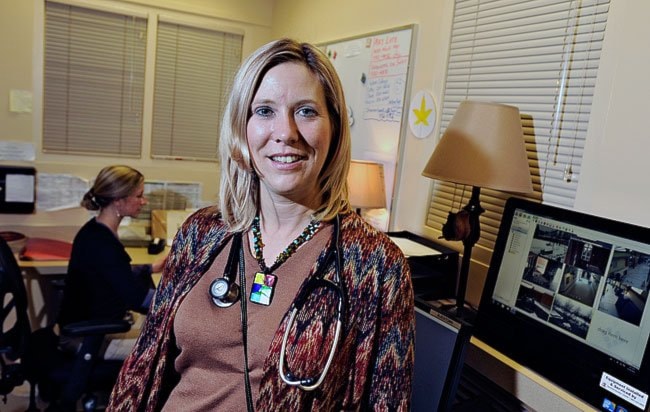When Hazel Booth first talked about working as a nurse practitioner in the Yukon, some people here looked at her as if she “had four eyes.”
They just had no idea what she was talking about.
She’s been working permanently here for about 10 years. Before getting a job in Whitehorse, she was a primary health-care nurse in the communities. But she was limited. Patients would need birth control, or certain antibiotics, and she couldn’t prescribe them.
In Ontario, where she’s from, she could have. But she was in the Yukon - the nation’s last jurisdiction to grant licences to professionals like Booth, nurse practitioners.
Nurse practitioners are experienced registered nurses who have at least a master’s degree in nursing. They are legally allowed to diagnose, communicate diagnoses and prescribe medications, tests and therapies. Depending on their training, they can perform tasks like making stitches, skin biopsies or casting. Recent federal legislation allows them to prescribe narcotics too, said Booth.
In Ontario, Booth was licensed to work as a nurse practitioner. But until last November, nurse practitioners could not be licensed here. They could only work as registered nurses, despite their advanced training. Booth is the first nurse practitioner licensed to practise in the territory. She received her licence earlier this month.
But it was an interest in working in northern communities that motivated Booth to become a nurse practitioner in the first place.
While working as a nurse in a neonatal intensive care unit in Ottawa, Booth saw an ad for a nursing job in northern communities. She applied, and found herself in northwestern Ontario, working in fly-in First Nations communities. Some had no running water and some of the world’s highest suicide rates.
She saw patients with rashes, not because they were sick, but because the community had just gotten running water, and residents weren’t used to being able to bathe frequently.
She knew she needed more training to continue working in these situations. She did her master’s degree, focusing on aboriginal youth suicide. In 2001, she came here after hearing about Yukon’s First Nations. She was first sent to Beaver Creek. “I thought I was going to be getting off the plane and going to tundra, blowing snow,” she said. But it wasn’t weather that disrupted her first drive through the Yukon. On the drive, she stopped so a bear could cross the Alaska Highway, a fish dangling from its mouth.
“And thus began the classic Yukon story,” laughed Booth.
For a few years, she travelled from Ontario to work here temporarily. She’s been here permanently for about a decade. At first, she was a “typical” Yukoner, with “one foot out the door,” she said. But with a family here, she’s not looking to leave.
That’s good, because nurse practitioners are key on health-care teams, especially when doctors are scarce. Several studies show nurse practitioners have equivalent training to family doctors, said Booth.
But changing Yukon law was just one step in a long journey. After the legislation passed, licence requirements had to be developed. Then, Booth needed a billing number for prescribing medications. Now, she is officially in the system. She received her licence earlier this month.
She’s been working with the continuing care branch of Health and Social Services since September, before the legislation passed. At first, she looked at gaps in the health-care system to see where a nurse practitioner could work. She also consulted with doctors about patient care, and studied gynecology. Most of her training is in general medicine.
“The role is meant to complement, not replace, anything that’s in existence,” said Booth.
She works with staff and residents at Whitehorse’s continuing care facilities. Many of the patients have dementia, so when an infection causes their pain to rise, they may not be able to communicate what’s wrong. It’s Booth’s job to help figure out what the problem is and prescribe treatments.
Before, only doctors could prescribe treatments and medications. Depending on their schedule, that could take days, said Booth.
“It’s a really beautiful role, because I’m on the ground, I’m right here,” said Booth.
Eventually, she may work with home-care patients, as well.
That’s good, because any part of our health-care system could use nurse practitioners, said Sean Secord, president of the Yukon Registered Nurses Association.
Now, governments need to create jobs for them, he said. There are about half-a-dozen nurses in the Yukon who are licensed to work as nurse practitioners in other jurisdictions. Secord has a licence from Ontario. But so far, Booth’s is the only nurse practitioner job that exists. Nurses have left the territory so they can practise as nurse practitioners elsewhere, he said. Sometimes nurses have to leave the territory temporarily to work in other provinces or territories so they can maintain their licences, said Secord.
“Just like anything else, if we don’t provide them with meaningful opportunities to work, they won’t be able to stay here,” said NDP leader Liz Hanson. The Opposition has been calling for nurse practitioners licensing for years.
“Sometimes, the territory is ahead of the curve. On this one, we’re way behind,” she said.
But being last is good in some ways, said Booth. Yukon can draw on other jurisdictions’ experiences to better develop jobs for nurse practitioners. They need to be involved in creating the positions, she said.
She’s seen the tremendous difference her job is making in continuing-care, and she’s confident nurse practitioners can do the same elsewhere, she said.
Contact Meagan Gillmore at
mgillmore@yukon-news.com
